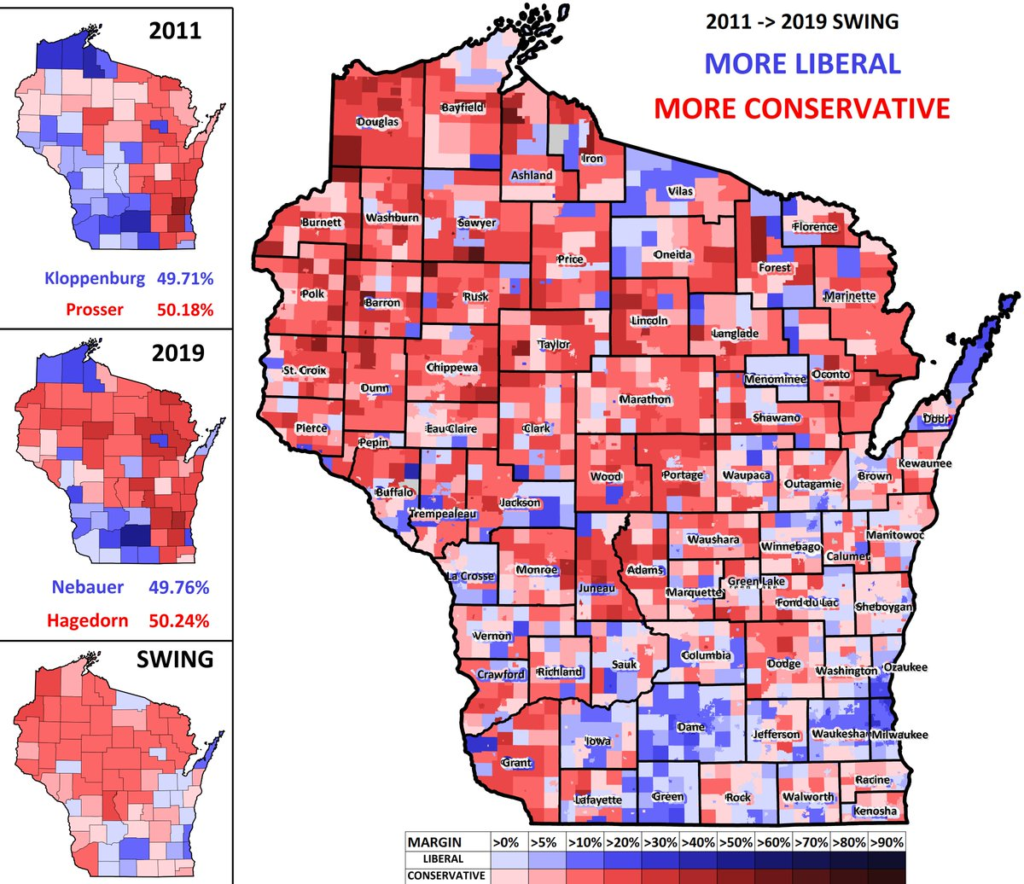Following up on our initial post on last week’s Wisconsin court race, here are a few other bonus maps. Since then, judge Lisa Neubauer (Democratic-aligned) has conceded to conservative Brian Hagedorn, after trailing by roughly 6,000 votes. This leaves the conservatives with a 5 to 2 majority on the Wisconsin Supreme Court.
One request I received often was to look at turnout, and how that may have impacted the race. Though the 2018 court race was a 12% win for the liberal candidate, I felt, in terms of turnout, it offered the best apples-to-apples comparison.
Statewide, turnout in the 2019 court race was just below 30%, but even this was an increase from last year. Compared to 2018, 21% more votes were cast this year (121K compared to 99K).
In this map, blue towns cast more votes in 2019 than 2018, while turnout was down in red towns. To some extent, this map reflects the population. Larger municipalities (such as Madison, Milwaukee, and Green Bay) saw this biggest increases in raw votes being cast. An interesting exception to this trend was Manitowoc, which is crimson.
 Looking at this another way, by percentage change as opposed to the raw vote difference, we can see how the electorate was more favorable to conservatives this year. Counties in the rural north tended to have the highest percentage increase in turnout. Counties that make up the 8th Congressional District, in the northeast, especially stand out:
Looking at this another way, by percentage change as opposed to the raw vote difference, we can see how the electorate was more favorable to conservatives this year. Counties in the rural north tended to have the highest percentage increase in turnout. Counties that make up the 8th Congressional District, in the northeast, especially stand out:
For many Badger State political observers, the outcome, and margin, of the 2019 court race hearkened back to 2011. That year, right after Gov. Scott Walker (R) took office, Democrats went all-out to defeated conservative justice David Prosser with liberal JoAnne Kloppenburg. The result was a narrow win for Prosser – thanks in large part to his showing in the famously ‘crucial’ Waukesha County.
The change over the eight years shows that, in terms of geography, court elections in Wisconsin have essentially become more Presidential. Compared to Kloppenburg, Neubeauer was more reliant on the Madison and Milwaukee metros; her gains there were cancelled out by much of the rural north getting more conservative. This map from Drew Savicki shows the swing at both the town and county levels:

Broken down by Congressional District, the pattern is still obvious. All eight districts voted the same way in each election, but the change in margins was telling.
Neubauer improved nearly 10% over Kloppeburg in the Milwaukee-based WI-04, and posted an even larger 12% gain in WI-02 (Madison). Likewise, the suburban 5th district – historically the state’s most reliably GOP seat – drifted leftward. By contrast, district 7 was almost tied in 2011, only to give Hagedorn a 15% margin this year WI-03, in the swingy west, actually voted for both liberal judges, but moved 7.5% to the right. Still, probably the most disappointing part of this map for liberals is that Neubauer’s home district, the southeastern WI-01, got slightly redder:
If there’s any good news for liberals here, it’s that the timing of the 2020 court race should favor them, as it will be held during the Presidential primary. The crowded Democratic field should draw their voters to turn out, while the President will (likely) have little competition on the GOP side. Justice Daniel Kelly, a Walker appointee to the court, has not announced whether he’ll seek a full term. Either way, I’m sure we’ll be mapping it to the town-level.


